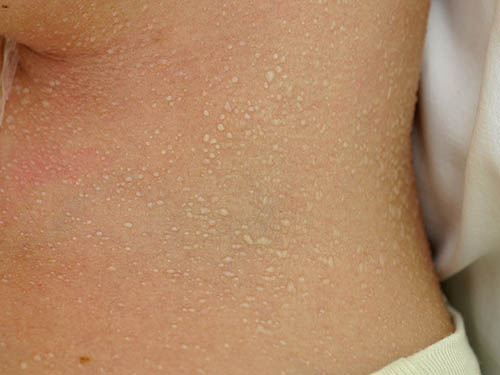What does prickly heat look like in infants?
As a rule, prickly heat is characterized by damage to the skin of a child, the appearance of rashes. This happens due to the fact that sweating is increased, as well as due to improper skin care.
Miliaria in children is manifested by a small-point rash in the form of bubbles or nodules, foci of oozing, burning and itching of the skin. All this causes anxiety in the child.
 Types of prickly heat in newborns
Types of prickly heat in newborns
In children, the following types of prickly heat are found:
- crystalline
- red
- white
With red prickly heat, small nodules appear on the child's skin. Around everyone, the skin turns red. Unlike a rash with crystalline prickly heat, nodules do not develop into large lesions. Itching is common in prickly heat, which can lead to severe anxiety in the child and loss of appetite.
Most often, this type of rash appears on areas of the skin that are constantly exposed to friction. This further aggravates the child's itching and pain.
White and yellow prickly heat in children suggests that the child has a secondary infection - most often staphylococcal. White prickly heat is also called vesiculopustulosis. In the rash with these forms of the disease, milky-white or yellow pus is concentrated.
 Prickly heat treatment
Prickly heat treatment
Air temperature around +20 ° С
To regulate the heating in an apartment building, you can purchase special regulators for the heating system. They allow you to reduce the room temperature to the desired values.
Relative air humidity 50-70%
You can measure air humidity using a hygrometer, and a special device - an air humidifier - will help create the desired climate. You can also use damp towels hanging around the radiator or an aquarium that can be set up in the nursery.
Clothes made from natural fabrics
Clothing should only be made of natural fabrics, synthetics and semi-synthetics are best avoided. It is imperative to give him water baths every time before changing clothes for a child and before changing a diaper - this is both hardening and a way of treating prickly heat.
Bathing
The child should be bathed daily, but without the use of soap. It is also better to refuse to use a solution of potassium permanganate. For bathing, you can use decoctions of medicinal plants - sage, chamomile, string, older children - a decoction of celandine.
Medicinal therapies
The main requirement for remedies for treating a problem such as prickly heat is a slight drying property. You need to use only those preparations that dry the skin and create a protective layer.


